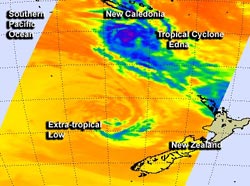NASA Sees Tropical Cyclone Edna Affecting New Caledonia

NASA's Aqua satellite spotted two storms in the Southern Pacific Ocean on Feb. 5 as Tropical Cyclone Edna brushes by New Caledonia and an extra-tropical storm lingers west of New Zealand. <br>Image Credit: NASA JPL, Ed Olsen<br>
New Caledonia warnings were still in effect on February 5 as Edna continues moving along the southwestern part of the island. An Amber Alert was in effect for the whole southern province as well as the community of Canala and a Yellow Alert was in effect for the rest of the territory.
NASA's Aqua satellite passed over the area of the Southern Pacific Ocean where Tropical Cyclone Edna was positioned, about 89 nautical miles west of New Caledonia. It was centered near 22.1 south and 164.5 east and moving south-southeast at 20 knots. Edna's maximum sustained winds were near 50 knots and tropical storm force winds were affecting New Caledonia. Edna was also generating wave heights to 19 feet as it continued to move parallel to New Caledonia today, February 5.
AIRS and multispectral data showed that the convection (rising air that forms the thunderstorms that make up the tropical cyclone) have begun to break up on the southern side of the storm where wind shear is increasing.
The Joint Typhoon Warning Center expects Edna to maintain intensity as it moves southeast over the next couple of days. As Edna moves southeast it is expected to encounter cooler waters and stronger wind shear that are expected to weaken and dissipate the storm as it nears northern New Zealand.
An extra-tropical low pressure area located west of New Zealand also appeared in the AIRS imagery. AIRS data showed that the strongest storms associated with it were southeast of the center. The low is expected to move to the north and the west and away from New Zealand, according to the New Zealand Met Service or NZMS. NZMS noted that high pressure located to the southeast of New Zealand is expected to push the extra-tropical low away.
Text credit: Rob Gutro
NASA's Goddard Space Flight Center
Media Contact
All latest news from the category: Earth Sciences
Earth Sciences (also referred to as Geosciences), which deals with basic issues surrounding our planet, plays a vital role in the area of energy and raw materials supply.
Earth Sciences comprises subjects such as geology, geography, geological informatics, paleontology, mineralogy, petrography, crystallography, geophysics, geodesy, glaciology, cartography, photogrammetry, meteorology and seismology, early-warning systems, earthquake research and polar research.
Newest articles

High-energy-density aqueous battery based on halogen multi-electron transfer
Traditional non-aqueous lithium-ion batteries have a high energy density, but their safety is compromised due to the flammable organic electrolytes they utilize. Aqueous batteries use water as the solvent for…

First-ever combined heart pump and pig kidney transplant
…gives new hope to patient with terminal illness. Surgeons at NYU Langone Health performed the first-ever combined mechanical heart pump and gene-edited pig kidney transplant surgery in a 54-year-old woman…

Biophysics: Testing how well biomarkers work
LMU researchers have developed a method to determine how reliably target proteins can be labeled using super-resolution fluorescence microscopy. Modern microscopy techniques make it possible to examine the inner workings…





















